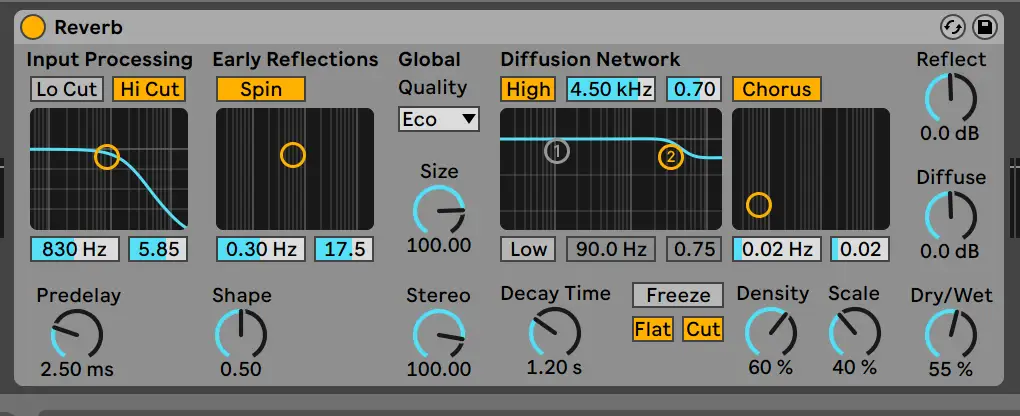Have you ever wondered why your processed vocals sound completely different from your dry vocal sound? Adding reverb to a vocal track can make a world of difference, making reverb one of the most popular vocal effects across all genres of music.
While expertly applied reverb sounds effortless, there is some technicality behind building a smooth vocal reverb chain. Below, we'll share the different types of vocal reverb and detail some key vocal reverb tips so that you can make your main vocal, background vocals, and beyond shine in every session.
Understanding Vocal Reverb
Reverb is a common time-based effect that is used to simulate the sound of sound waves reflecting off of surfaces like objects, walls, or the floor. Have you ever been to a church or wide, open area and noticed that your voice carries differently than it might in a smaller room? This is because the natural reverb quality is different in various spaces. Just listen to this natural sound of reverb from YouTube creator Max:
We come across natural vocal reverb on a regular basis, but we can also use reverb effects and plugins to simulate this phenomenon. Reverb is commonly used on any voice sound across many genres - you'll find reverb on the lead vocal, backing vocals, lead instruments, and more.
There are several different types of vocal reverb (and reverb in general) that can be used to create atmospheres ranging from a retro sound to a dreamy, ethereal vocal stack.
Unlocking The Components of Reverb
Every reverb comes with its own set of controls that can be used to create different sonic atmospheres for your audio signal. Below, you'll see the stock reverb provided in Ableton Live, but every DAW, whether you use Pro Tools or Logic, will have a reverb with similar controls.

This particular effect has a built-in reverb EQ labeled "input processing" to alter the natural sound of the signal before it is processed by the reverb. From there, essential settings like pre-delay, decay time, quality, scale, and density can all be adjusted to meet the demands of the space you're trying to recreate.
Reverb decay determines how long a reflection will last. For instance, if you're trying to create a space that boasts a room's exaggerated reflections, you'll likely use a long decay time and larger scale. In cases where you don't want to drown out the lead vocal with too much reverb, this decay time may be relatively short.
The dry/wet knob controls how much of the dry vocal channel is being processed through the reverb effect. If your reverb plugin of choice does not have a dry or wet knob, you add reverb to an auxiliary track or send track and send the signal of your vocal to it instead.
4 Different Types of Vocal Reverb
Each different type of reverb adds its own level of vocal character to the track. Here's what your ears expect from these main categories of reverb:
Plate Reverb
Plate reverb is known for its characteristically warm, retro vibe found in classic rock recordings. This reverb has a smooth decay and has a warm feel to the reverb signal. It's not optimized for vocal clarity, but ideal for something more stylized.
Hall Reverb
If you want a more immersive vocal, a hall reverb sound will send any listener into a majestic and spacious realm. This artificial reverb mimics large halls and spaces, which is great for creating expansive spaces within your music.
Chamber Reverb
Chamber effects put your signal into more dark, slightly diffused reverb spaces creating an epic, lush effect. This reverb has a long tail and can be used for dramatic effect.
Room Reverb
Out of the different types of vocal reverb we've discussed, room reverb is most likely to be the most subtle and realistic to the original signal. This reverb space is built to emulate a small room, highlighting key vocal frequencies in the original recording.
Keep in mind that every reverb is different. While these descriptions should give you a basic sense of a couple of types of reverb, the best way to understand your effect toolkit is to hear how they are actively affecting your audio. Just take a listen to these various reverb effects in action:
Should Vocals Be Recorded With Reverb?
Unless you're capturing the natural reverb of a space, it's best to record vocals without any effects (like reverb) baked in. This way, you have full control over adjusting the balance between the clean vocal, and the processed signal.
How much reverb is good for vocals?
The amount of reverb you use on vocals is ultimately up to you and the context of the vocal. Different reverb types will affect the processed signal in several ways. You'll also find that the balance of reverb on a single vocal track versus multiple vocals can shift the sound significantly. Genres that call for a more natural sound may utilize minimal reverb effects, whereas genres like shoegaze, rely on the spacious reverb effect.
Just listen to the drowned-out vocals in My Bloody Valentine's When You Sleep :
7 Tips for Using Vocal Reverb
Using vocal reverb properly is nothing short of an art! Here are a couple of reverb techniques to experiment with on your next track:
Be Mindful of Your Reverb Tail
Keep in mind that your reverb has something referred to as the "reverb tail", which essentially refers to the sound of the decay signal that comes after the initial processing. A reverb tail can be surprisingly long but go undetected when not evaluated carefully. Simultaneously, an unnecessary reverb tail can lead to multiple spaces clashing across your song. Double-check the limits of your reverb, and be sure to cut off the tail as needed to make room for other frequencies in your mix.
Audition Different Reverb Settings
There are plenty of different types of reverb and a whole world of reverb settings within each plugin. The best way to find the right vocal reverb is to audition different plugins on your vocals to find the right fit for any particular piece of work. You might also experiment with using different types of reverb across your song to keep your listeners engaged.
Experiment with Parallel Processing
Placing your reverb on an auxiliary or a send track opens up the door to parallel processing. Instead of placing the effect directly on the unprocessed sound, parallel processing allows you to "send" some of your signal to the auxiliary bus and blend the processed signal with the original, unprocessed sound.
This approach can give you more control over the reverb itself. For instance, you can EQ the reverb and conduct additional adjustments on the aux track. It can also help you preserve the original signal's dynamics since you're opting to blend the two outputs rather than entirely coat it in an effect.
EQ Your Reverb Sound
Attenuate key vocal frequencies by accentuating them or cleaning them out with an EQ before being processed by reverb. Reverb tends to make sounds feel wider, so it's essential that you take the time to clean up your audio signal before you pass it through reverb or any time-based effect for that matter. Many reverbs even have a built-in EQ as well, so you can choose only to send certain frequencies through your processing chain.
This is great, especially for sounds that cover a wide swath of the frequency spectrum. Low frequencies can easily sound muddied when passed through reverb, so many engineers opt to cut out the low end on a reverb EQ.
Bypass Reverb For Emphasis
Silence is just as important as sound when it comes to making an amazing mix. Consider bypassing or automating your vocal reverb off on select words, or sections in the song that you want to stand out. You can also create a less dramatic effect by bypassing the reverb tail sound using a gate or volume automation.
Play With Panning
Reverb creates a feeling of width, which can be incredibly effective when paired with panning. Create distance between different vocal tracks by placing various amounts of reverb, and panning each track to several points across the stereo field. This can be especially fun with playing with a large group of backing vocals or harmonies.
Automate With Reverb Over Time
Create a sense of growing by automating the dry/wet amount of reverb over time. You can also utilize more reverb in select sections of your song. For instance, it's common for the chorus of the song to have a wider, more dramatic feel in contrast to the verse. You might automate for reverb to come in at a stronger potency during the chorus.
You can also automate the reverb itself if it's set on an auxiliary track. You might automate a high pass filter to open up the scope of the reverb settings over time for dramatic effect.
Reverb on Vocals FAQ
It's time to put some reverb on your vocal tracks! Use these commonly asked questions and answers to guide your vocal processing journey:
Is reverb the same as echo?
Echo is the controlled repetition of a specific sound, whereas reverb simulates the reflection of a sound off of a surface. Reverb and echo can sound similar, but they are distinct time-based effects.
What does it mean when a song is reverb?
When you add reverb to a song, you are simulating the reflection of sound waves in a live space. This creates atmosphere and gives vocals, instruments, and more character and atmosphere. Artificial reverb is used in nearly all genres of music.
What is reverb in singing?
Reverb is the sound of a sound source bouncing off of the surfaces around you like the walls and the floor. It creates a rich, lush, sound that is often used to accentuate vocals and other instruments within a mix.
What reverb is best for vocals?
The best type of reverb depends on what kind of vocal effect you're going for. For example, for a more vintage feel, you might opt for a plate reverb. If you're looking for something with more vocal clarity, you might opt for a stereo reverb that represents the space you're attempting to recreate.
What is the difference between Auto-Tune and reverb?
The creators of Antares Autotune also have a vocal reverb plugin with several algorithmic reverb types, reverb EQ, and several pre and post reverb effects. Autotune is a vocal tuning plugin, whereas the vocal reverb plugin is designed to apply reverb directly to a track or as a part of a reverb aux channel.
What effects make vocals sound better?
There are no hard and fast rules when it comes to improving vocals since every genre of music calls for its own set of considerations. Some popular effects for vocals include tuning, reverb, and delay, though this merely scratches the surface of sonic possibilities.
Nearly every modern song uses some level of reverb signal on vocal tracks for good reason. This time-based effect puts a natural voice into a vocal space, setting the lyrics of a song into a distinct sonic atmosphere. Enjoy using reverb and these techniques to enhance your vocal tracks in your next mix!





